Hawker Hurricane I, Athboy, County Meath, August 1941
The 21st August 1941 would finish with a third Royal Air Force
Hawker Hurricane fighter crashed landed in Ireland. It
would also result in the internment of the first member of the
Royal Canadian Air Force, though not the first Canadian airman
to be interned.
Two Hurricanes had already arrived intact in Ireland.
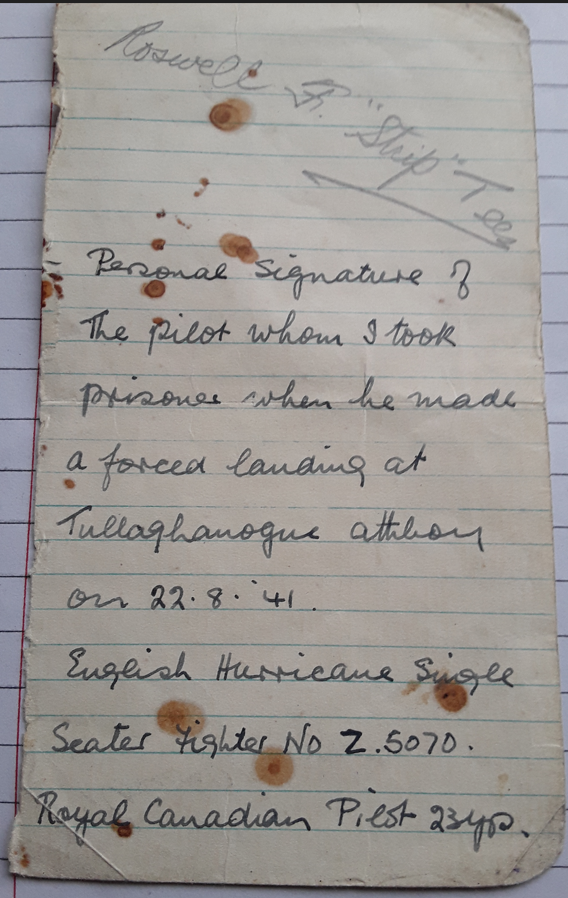 Locals from Tullaghanogue, a townland south east
of Athboy, assisted the pilot from his aircraft and he was taken
to the home of a Mrs Walker at Rathvale and given refreshment
until the LDF came and took him into custody. A member of
the Garda, the Irish police force, James F Collier, stationed at
Athboy Garda Station, was on hand to apprehend the pilot and he
obtained his autograph in a notebook and later recorded the
details of the incident with it. The pilot signed himself
as Roswell F 'Strip' Tees, a nick name that appears later in a
book by a fellow Allied internee.
Locals from Tullaghanogue, a townland south east
of Athboy, assisted the pilot from his aircraft and he was taken
to the home of a Mrs Walker at Rathvale and given refreshment
until the LDF came and took him into custody. A member of
the Garda, the Irish police force, James F Collier, stationed at
Athboy Garda Station, was on hand to apprehend the pilot and he
obtained his autograph in a notebook and later recorded the
details of the incident with it. The pilot signed himself
as Roswell F 'Strip' Tees, a nick name that appears later in a
book by a fellow Allied internee.
His aircraft was photographed on the ground and has appeared in
numerous publications, and is credited to a Norman Coffey in
Donal McCarron's book, Landfall Ireland. One can note that
the aircraft carried no markings forward and aft of the fuselage
roundal. Auxiliary long range fuel tank can be seen under
the wing.
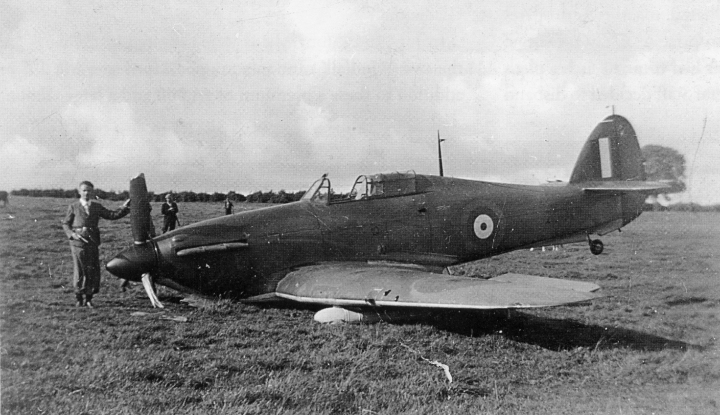
The following report was filed by Captain M Cumiskey, of the
Irish Air Corps to the Armies G2 branch on the 5th September
1941.
Forced Landing of British Hawker
Hurricane at Athboy, Co. Meath
Sir,
I append report on British Aircraft, Hawker Hurricane which
forced landed at Tullaghanogue, Athboy, Co. Meath.
Type of Aircraft
:- Hawker Hurricane, (According to Pilot
Mark II)
Condition :-
Aircraft landed with the under-carriage retracted on
slightly rough ground. Airscrew blades, Air Intake,
radiator and exterior tanks were damaged. It was less
damaged than the two previous Hurricanes, as the underside
was, to a large extent, protected by exterior tanks.
The Wireless receiving set was only other damage.
Cause of Crash :- Pilot stated he
had lost his way as Wireless Equipment had not been
functioning.
Mission :-
Stated by Pilot that a/c was being ferried between two
Aerodromes.
The service number of Aircraft was Z. 5070 and had no
Squadron markings. It was fitted with 10 Browning Guns
fixed, 3 in each outer wing in position normally occupied by
4 in previous Hurricanes and 2 further guns in each outer
wing. The 3 in board guns in each wing were loaded but
the outboard guns were not loaded. There was
approximately 900 rds of ammo. Tanks contained a total
of 20 galls of petrol. Two special exterior petrol
tanks were fitted approximately under the centre of the
inboard Gun Mountings underneath the wings.
The Wireless Received Type R. 3002 (similar to that in
Lockheed Hudson & Beaufighter) had been blown up.
Pilot stated that he had operated the switches for this
purpose. The Pilot was Sgt. Tees, - a Canadian and was
uninjured.
Captain Leonard, Intelligence Officer took away some papers
and one sidcot.
The following text is recorded in the Irish Army G2, Daily
Reports Summary No. 601:
A British aircraft came inland at GORMANSTON (CO. MEATH) at
15.09 hrs. and was subsequently reported from RUSH, CARDY'S
ROCKS, GORMANSTON, DROGHEDA, CLOGHER HEAD, LOUTH village and
west of BALLAGAN L.O.P. It then turned
south-west and was reported from KINGSCOURT
(CAVAN) and lastly from ATHBOY (MEATH) where it made a
forced landing at about 16.00 hrs. (see note 1 below).
Notes: 1. A British Hurricane fighter
aircraft made a forced landing in a field at Tollaghanoge,
Athboy, Co.Meath, at 16.00 hrs. on the 21.8.41,
The pilot, Sergeant Roswell Frank Tees of the Royal
Canadian Air Force, who was the only occupant, escaped
injury and was placed in military custody.
The machine which was armed with 10 Browning machine
guns and carried a wireless receiving set, sustained damged
to the undercarriage and propellor. The Pilot stated that he
took off from Bristol at 12.15 hrs. and was bound for Clyde
but got lost in the clouds and did not know where he was.
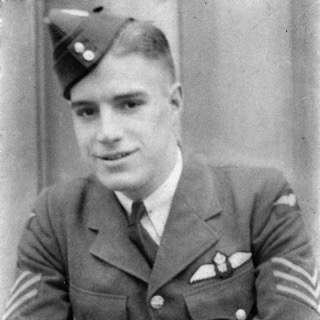 The pilot of the aircraft turned out to be a
member of the Royal Canadian Air Force, Sergeant Roswell Frank
Tees. Roswell was born to Jessie and Walter Tees in
Ontario in 1919. A summary of his Canadian service was
provided by Hugh Haliday and records that he enlisted in Niagara
Falls, Ontario on the 2nd of July 1940 and was posted to No.5
Equipment Depot on that date. He was next posted to No,1
Initial Training School on 16th August 1940 and graduated and
was promoted Leading Aircraftman (LAC), on 13 November
1940. He next moved to No.12 Elementary Flying Training
School located at Goderich. Following completion of that
training he went on to No.9 Service Flying Training School,
Summerside on 4 January 1941. While there, on 5th March
1941, he was involved in a crash when Harvard 2693 crashed while
landing. Luckily, neither he nor the instructor were
seriously injured and following another successful training
course, he graduated as pilot and was promoted Sergeant in
April 1941. He was posted to an embarkation depot
and embarked for overseas on 28 May 1941. He
then found himself in the United Kingdom in the summer of 1941
and undertook training on the Hurricane fighter at 59
Operational Training Unit. While there, he suffered two
forced landings, first with Hurricane V6669 at Ivegill near
Southwaite, Cumberland on June 26th, followed by Hurricane P3406
at Gretna Green on July 8th.
The pilot of the aircraft turned out to be a
member of the Royal Canadian Air Force, Sergeant Roswell Frank
Tees. Roswell was born to Jessie and Walter Tees in
Ontario in 1919. A summary of his Canadian service was
provided by Hugh Haliday and records that he enlisted in Niagara
Falls, Ontario on the 2nd of July 1940 and was posted to No.5
Equipment Depot on that date. He was next posted to No,1
Initial Training School on 16th August 1940 and graduated and
was promoted Leading Aircraftman (LAC), on 13 November
1940. He next moved to No.12 Elementary Flying Training
School located at Goderich. Following completion of that
training he went on to No.9 Service Flying Training School,
Summerside on 4 January 1941. While there, on 5th March
1941, he was involved in a crash when Harvard 2693 crashed while
landing. Luckily, neither he nor the instructor were
seriously injured and following another successful training
course, he graduated as pilot and was promoted Sergeant in
April 1941. He was posted to an embarkation depot
and embarked for overseas on 28 May 1941. He
then found himself in the United Kingdom in the summer of 1941
and undertook training on the Hurricane fighter at 59
Operational Training Unit. While there, he suffered two
forced landings, first with Hurricane V6669 at Ivegill near
Southwaite, Cumberland on June 26th, followed by Hurricane P3406
at Gretna Green on July 8th.
In the AIR81/8515 casualty report, there is the following
report dated 22nd August 1941, from Roswell himself. It is
not clear how he was able to make this report and have it
transmitted from Ireland.
Sirs,
I have the honour to report that on Aug.21, 1941, I was
detailed to fly Hurricane Z-5070 of the mark II type from
Hullavington to Abbotsinch in formation with three other
aircraft. Pilot Officer Lintern was to lead the formation. I
took off about 12.45 hours and circled the aerodrome to join
the others, I did not see them at first but finally spotted
them heading north. I set out after them but ran into broken
cloud and then thick cloud. I climbed to 12,000 feet to get
above the cloud and flew on a course of 3450. My directional
gyro began to spin around and I found that I had veered 30
off course since I last checked with the compass.
After about an hour and a half I saw an opening in the
clouds and circled down through it. I came down over water
with land about ten miles to the west. The ceiling over the
water was about 200 feet. I flew to the land and circled
around for about 30 minutes looking for an aerodrome but
could not find one. I had only 8 gallons petrol left in my
reserve tank so I landed about 1600 hrs. in a large field
with the undercarriage retracted, damaging the propellor,
the radiator, and long-range petrol tanks.
When I found I was in Eire I destroyed the I.F.F. The
authorities arrived and took my six maps and all log books
for engine, airframe, machine guns, and parachute.
No 10 Maintenance Unit based at Hullavington reported to the Air
Ministry that Tees had arrived at their station from RAF
Wilmslow at 0900 hours on the day of the crash. He
departed on the delivery flight to Abbotsinch at 1230 hours
Then on 5th September, 59 OTU at Crosby on Eden wrote to the
Air Ministry to advise that:
Sir,
R.66043 SGT. TEES.
I have the honour to refer to your signal P 6972 of 3/9/41
the above named Canadian Sergeant Pilot was posted from this
Unit to No 2 P.D.C. Wilmslow
w.e.f. 14/8/41 on operation ' Scarlet' .
2. The first intimation received of Sergeant Tees being
interned in Eire was telephone message from Air Ministry
(Dept.Al 3B) on the 29th August 1941 requesting that his
personal kit be forwarded to him.
This could not be done as all kit for operation 'Scarlet'
had already been forwarded.
3. 81 Group Signal P.148 of 2/9/41 received yesterday
stated that Sergeant Tees was not required for operation
'Scarlet' and was posted to 258 Squadron w.e.f. 3.9.41.
Operation Scarlet, in the context of August 1941, was part of a
operation known as Operation Scarlet and/or Operation Status
which entailed available pilots being sent around the UK to
collect Hurricane fighters for onward transportation to Malta on
the carriers Ark Royal and Furious.
During his time interned he appeared in this well known photo of
eight of the Allied internees at their own bar in the camp
itself. Roswell is the man pouring a drink, second from
left of the photo. His name, along with the other Canadian
internees appeared in many of the war time articles published in
Canada written by fellow Canadian internee, Jack Calder.
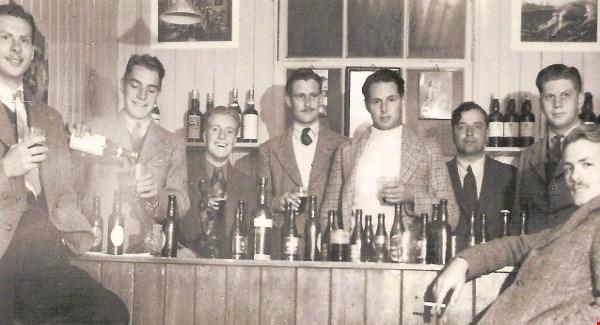
His name appeared in a number of wartime articles published in
Canada written about the Allied internees in Ireland.
Roswell Tees was one of the allied airmen who met and married a
local woman during his time interned. His local newspaper
The St Catherine's Standard carried a note on the 11th of August
1943:
Engagements
Mr. and Mrs. J. Lewis, of Wesleyan, Curragh, Eire, announce
the engagement of their eldest daughter Eileen, to Flight
Sergeant Roswell Frank Tees, only son of Mr. and Mrs. W.
L. Tees, Thorold. The marriage to take place in Curragh,
Eire, the middle of September.
On September 14th, 1943, just under a month before he would be
released, he married local woman Eileen Lewis from Wesleyan
House in the Curragh Camps Garrison Church. His witness
can be seen to be fellow Canadian internee Frederick William
Tisdall.

This event was the occasion for a gathering of twenty six
Allied internees and they appear in this amazing photo which has
appeared in a number of publications with the names recorded in
Ralph Keefer's book, Grounded in Eire.
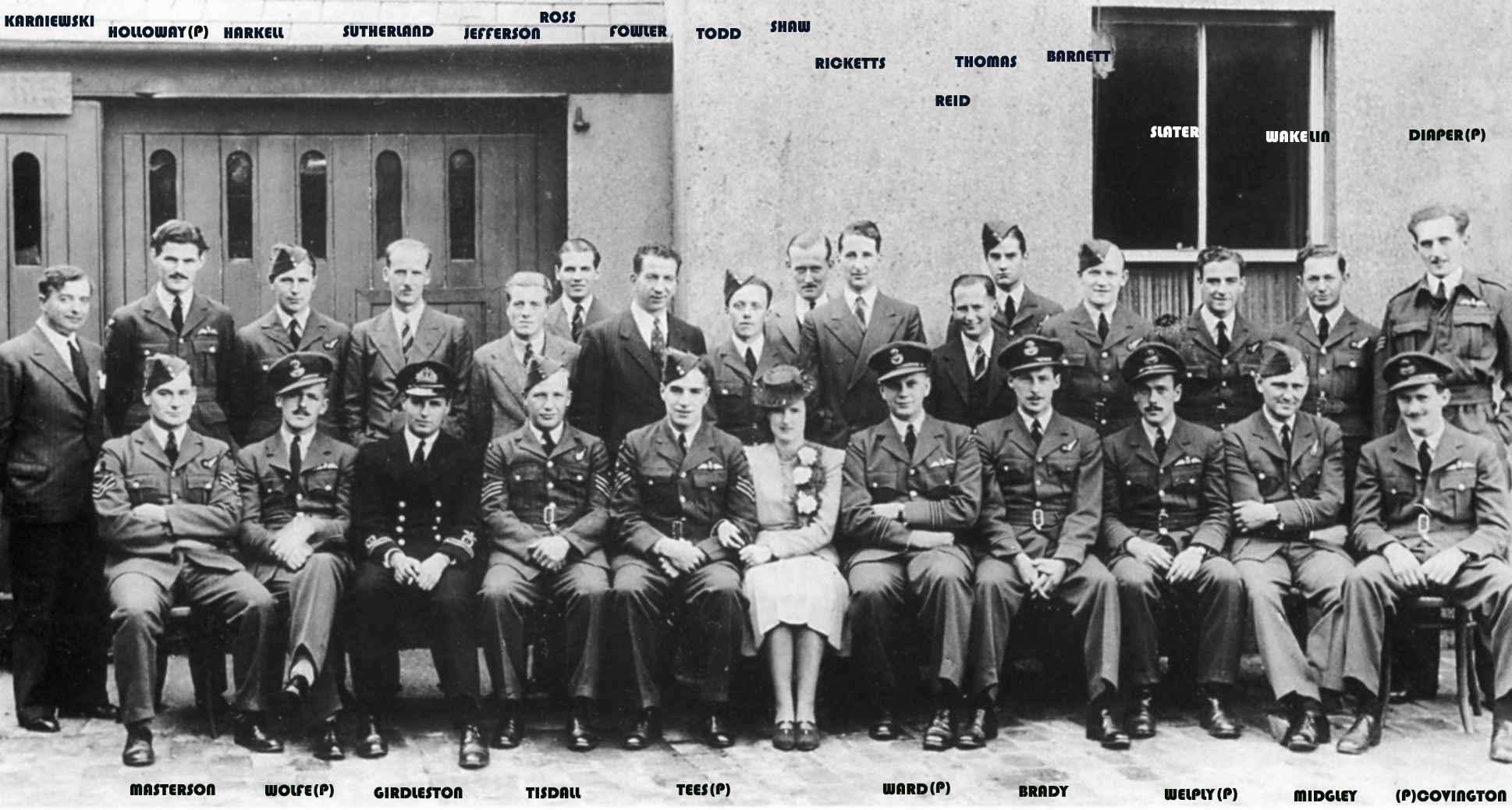
Roswell was one of eighteen men released from Internment on the
18th October 1943 with the closure of the original Allied
internment camp and the opening of the Gormanstown Camp for the
eleven men who remained.
Upon his arrival in the United Kingdom, he was questioned by
the MI9 organization and filed the following Escape and Evasion
report
1. Internment
On 21 Aug 41 I left HULLAVINGTON for ABBOTSINCH in a
Hurricane aircraft under movement order for Foreign
service. I lost touch with the other aircraft who were
doing the same trip and ultimately force-landed at ATHBOY,
CO. MEATH. I was immediately arrested and taken to THE
CURRAGH Camp on 22 Aug.
2. Attempted Escapes
(a) I took part in the ladder escape of Feb 42 and came
down from the ladder onto the wire, unhurt.
(b) In the escape through the gate on 17 Aug 42, I was
one of those detailed for detaining work at the
gate. I held on to the Irish Corporal at the gate,
but was the first man to be captured.
The St Catherine's Standard newspaper of Monday, November 27,
1944 carried a long column about four returned airmen and
included a remarkably accurate telling of Roswell's preceding
months.
Four Airmen Have Varied Experiences
PO. Roswell Tees Allanburg road,
Thorold South, has a different set of experiences to relate
to his friends than most of the current crop of returning
warriors. He listed in the RCAF in July, 1940, and was,
posted overseas the following May. On arrival in England he
was assigned as a fighter pilot to deliver a Hurricane
fighter to a base in the northern part of the British Isles.
Heavy clouds obscured his view and when he finally set
his plane down he found, much to surprise, he was in neutral
Ireland. He was of course interned and spent the next two
years in the internment camp in Curragh along with eight
other Canadian flyers and many from other parts of the
Empire. Internees there are allowed to leave camp provided
they return the same night and provided they sign a parole
sheet saying they will return. Should they not do so but
return to their own country they are immediately sent back
to the camp. This is international law.
In camp, however, they may try to escape and try they
did. Quite number managed to get away, including two
Canadians, PO. Keeper of Montreal and Flt. Lt. Fleming,
D.F.C., Calgary.
Tees was one of the unlucky ones who were caught.
During one of his leaves from the camp he met a lovely Irish
girl and eventually married her. When he was finally
released and returned to England, she followed him there. He
is now back in Canada on leave and his wife and their months
old baby daughter, Joyce, are expected to arrive early in
the new year.
Ros Tees
undoubtedly had a stroke of luck in having been interned in
Ireland. On that fateful day in 1941 when he departed
Hullavington, he was flying with three other airmen, Sgt's
Knappel, Lintern and Metherall. All three would be dead by
the end of May 1942.

Roswell and Eileen are pictured above.
Roswell was commissioned as an officer on 24 April 1944. He was repatriated to Canada on 3 November 1944 where he was posted to No.4 Release Centre on 27th February 1945. He was released from RCAF service on 21st March 1945.
Eileen would follow him to Canada in late 1945, and was
welcomed by a party held in a local woman's house in October
1945 where a dainty lunch was served and games were played, all
reported on by the St Catherine's Standard.
Following his return to Canada Roswell left the Air Force and
worked as an electrician until 1961 when he and Eileen decided
he would study to become an Anglican Deacon, which he was
ordained in June of 1964. He then served as a priest for
the rest of his life. He corresponded with Irish
journalist Ryle T Dwyer around 1977 about his time in Ireland
and Ryle had an article published in 1977 followed by a longer
four page magazine style feature in March 1978 in papers all
across Canada. Ryle would later go on to publish the book,
Guests of the State.
Roswell Tees passed away in January 1981 after a long
illness. His newspaper obituaries mentioned his time
interned in Ireland.
Hurricane Z5070 itself led a busy, yet uneventful career during
world war two. It was built by Gloster in the summer of
1941 and delivered to 10 Maintenance Unit (MU) at Hullavington
in the middle of June 1941. It was assigned to the Scarlet
delivery program and was destined for Scotland and thence the
Mediterranean. It would, as described above, find itself
stuck in Ireland but the Irish Government sought to purchase the
aircraft and with the aid of the air ministry, return the
aircraft to flying condition. She was repaired, but did
not return to flying until the middle of 1942 when it joined the
Irish Air Corps Training School carrying the serial number
95. It remained in Irish Service for only a few months
when it was returned to the RAF upon receipt of a larger batch
of Hurricanes in July 1943. It was flown to
Newtonards in July 1943 and issued to 55 Operational Training
Unit, with which unit it flew for a year before making its
biggest contribution to the war, when it joined 527 Squadron in
the summer of 1944. With them, it would be flying
radar calibration tests, used to ensure that Britain's radar
system was functioning properly. In the end, it was
scrapped some time likely in 1945 or 1946
Compiled by Dennis Burke, 2024. With thanks to the family
of Roswell F TEES.
